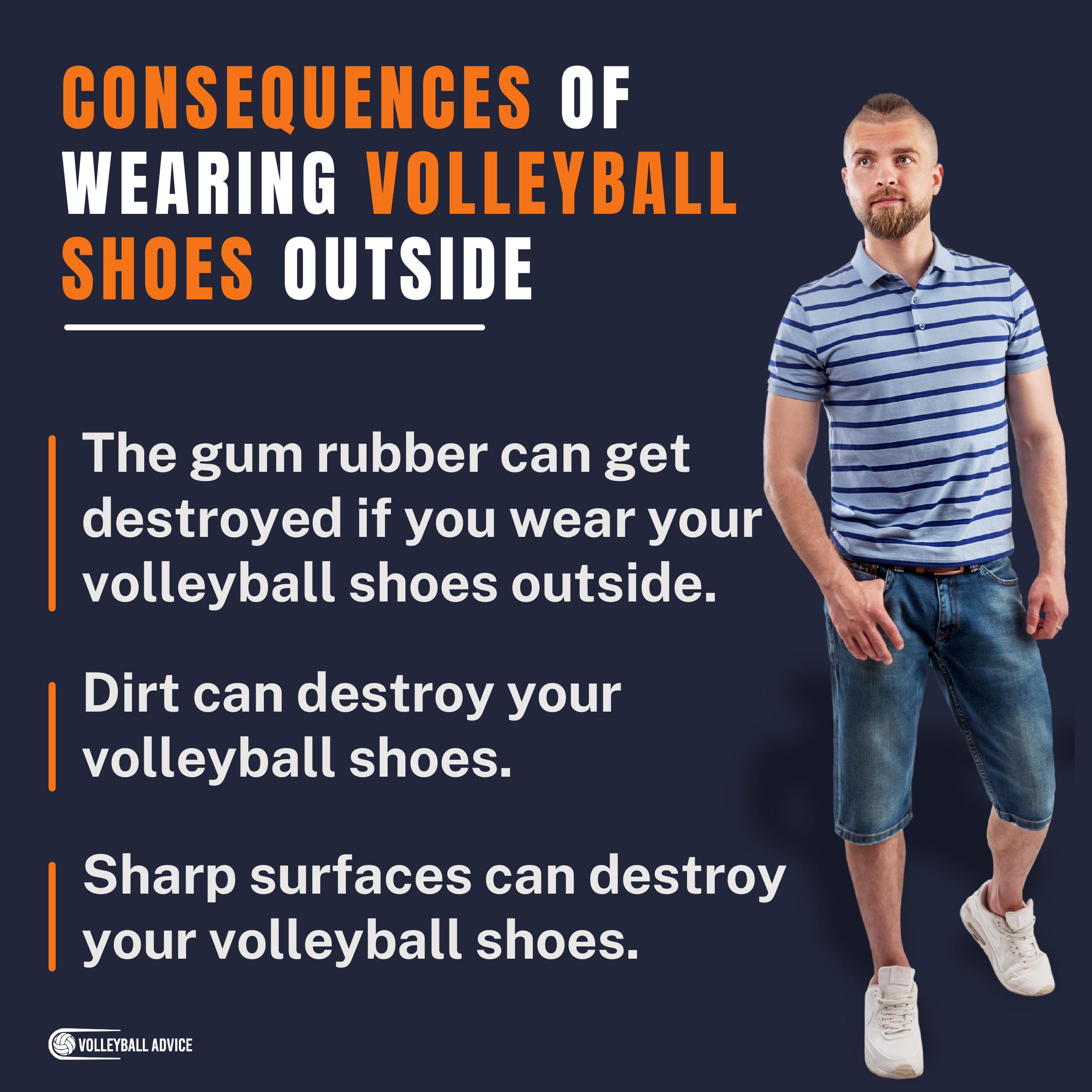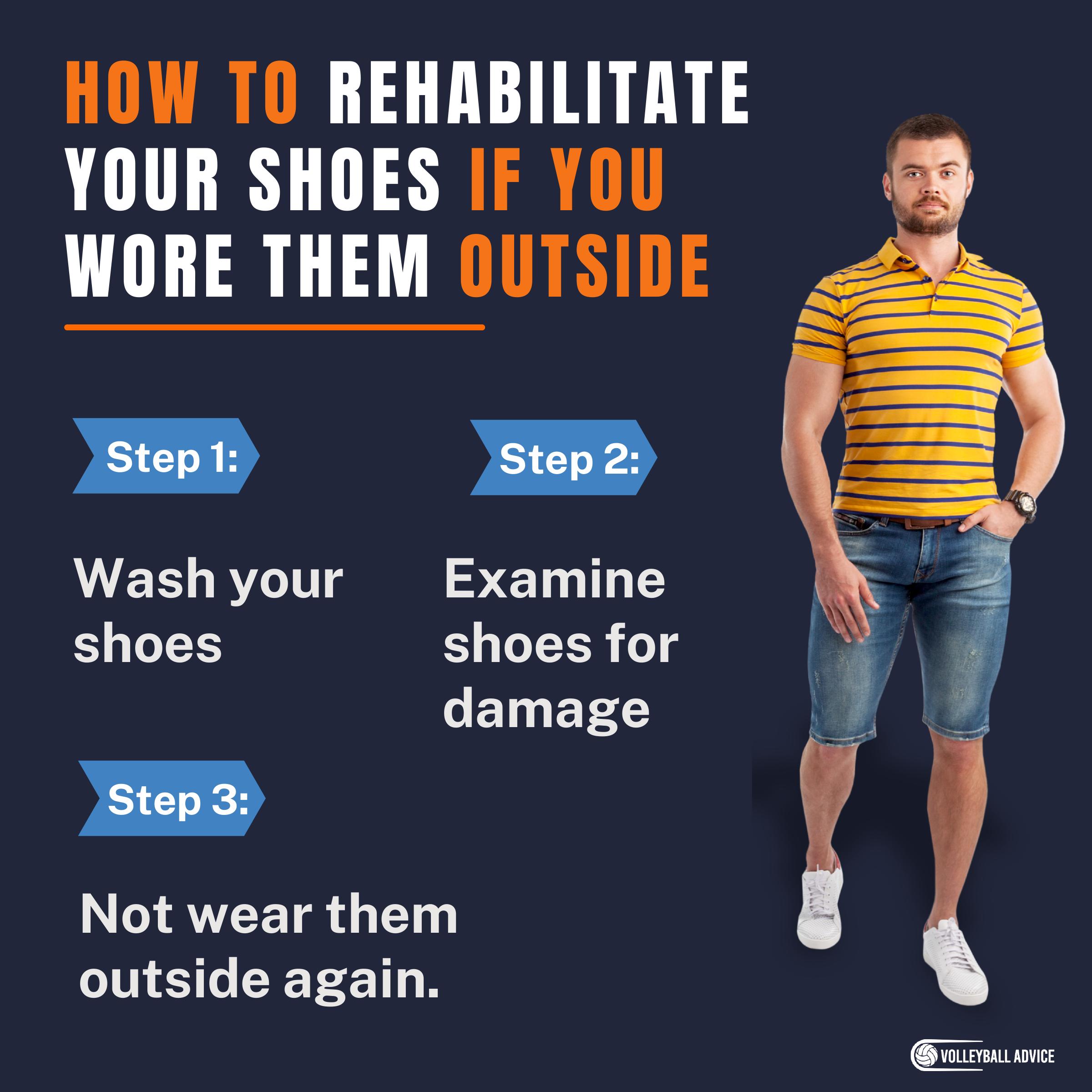Can You Wear Volleyball Shoes Outside? We Asked A Coach
There is no faster way to destroy your volleyball shoes than to wear them outside.
While most volleyball players know this and keep their shoes securely in bags with shoe compartments to and from practice, it’s not surprising to see some new players wearing their shoes proudly around town.
So, can you wear volleyball shoes outside? You should never wear volleyball shoes outside as the specialized rubber soles will quickly degrade. While wearing your volleyball shoes outside once may not spell the end of their lifespan, it will begin a cycle of deterioration that only ends with unnecessary wear and tear.
Wearing your volleyball shoes outside will result in needing to clean them frequently at best, and having to replace them at worst, setting yourself back around $100. This is not only a waste of money, but a waste of time as well. Sacrificing your shoes’ integrity will make you less safe on court, and potentially even lead to injury.
Yet, all this could have been avoided by not wearing your volleyball shoes outside.
In this article, I’ll be discussing:
- Consequences of wearing your volleyball shoes outside
- Some shoes that work better on outdoor courts
- A few tips for rehabilitating shoes
Consequences of Wearing Volleyball Shoes Outside
Volleyball shoes are – by and large – designed for use on indoor courts. While they have several unique components that make them the most effective footwear for volleyball, there’s only one that matters most: gum rubber.
The Gum Rubber Can Get Destroyed If You Wear Your Volleyball Shoes Outside
Gum rubber is a fantastically grippy material that is used to coat the bottom of almost every volleyball shoe (and basketball shoes too, for that matter).
It provides amazing traction while remaining incredibly lightweight, and has many cushioning properties as well, due to its chemical makeup.
The thing about gum rubber is that it rates incredibly low on the durability factor. It can be destroyed and pulled apart with your bare hands – though not without some effort – and to wear it outside is practically a death sentence for it.
This is because of two reasons: dirt and surfaces.
Dirt Can Destroy Your Volleyball Shoes
Firstly, and less worryingly, gum rubber seems to gather more dirt than the most powerful vacuums in the Dyson HQ.
Even inside, on a well maintained court that has been dust mopped, volleyball shoes gather significant amounts of dust and other debris on their gum rubber soles. This makes players have to stop often and wipe their soles to regain traction, but if the dust remains they may slip and fall.
Think then, of how wearing gum rubber soles outside would work. Even walking on the pavement, countless small rocks, dirt, and other debris would attach itself to the gum rubber, making holes in the sole and creating tears with every step.
Admittedly, this happens slowly, but over time you’ll find your beautiful, scientifically textured rubber has been worried away and turned into chaff.
This brings us to our second point, about surfaces.
Sharp Surfaces Can Destroy Your Volleyball Shoes
Walking on rough surfaces only expedites this process that began with dirt. Sharp rocks slice through gum rubber like paper. Mud coats the sole and requires deep, constant washing to restore the grippy qualities. And sand – soft though it be – may be the worst overall.
It’s worth noting that some grass volleyball players like to use volleyball shoes to play on their outdoor courts, but there are unilaterally old shoes that have been cycled out of use indoors. They are used not for their grip outdoors, but for the other benefits they offer.
As such, this example should be ignored. Head over to my article about the best grass volleyball shoes if you’d like to learn more about this.
It only remains to state the obvious: if you wear your volleyball shoes outside, you’ll need to replace them far faster than you would otherwise.
If you don’t, playing on damaged soles will sacrifice not only your safety, but your effectiveness on court. You’ll find that you react slower, find it difficult to move, and your feet will be sorer – having lost the added cushioning of gum rubber.
In sum, it is a total waste of money, time, and safety.
Key Takeaway
Gum rubber performs best and lasts the longest when used exclusively on the surface it was designed for: indoor wooden (or rubber coated) courts that are perfectly level and have been mopped clean of dust and other debris. The outdoors is the exact opposite of this description, and wearing them there is the fastest way to destroy them in full.
Are There Volleyball Shoes That Are Better For Wearing Outside?
So far, I’ve demonstrated that wearing volleyball shoes outside is a bad idea, all around.
As almost every volleyball shoe uses gum rubber, I cannot recommend any volleyball shoes to wear outside in good conscious. They are not durable enough to remain useful, and the traction patterns in the gum rubber cannot handle the varying surface elements of outdoors.
However, basketball shoes are another matter entirely.
While most basketball shoes nowadays are made with indoor courts in mind, making them good choices to play volleyball in as well, there are some lines that have kept durability and dual-purpose traction patterns in mind when designing them.
Of these, I’ve chosen two to put forward that I believe would work the best outdoors and – hopefully – last the longest.
Keep in mind that the two products you’re about to read are still primarily intended for indoor play, and will eventually need replacing also if continually used outdoors.
If you are looking to purchase shoes to play street volleyball, I would recommend either running shoes with good ankle support or the following options:
Kyrie Flytraps
Unique in the Kyrie line, the Flytraps appear to cater more towards outdoor players than indoor, using heavier, more durable rubber outsoles that perform well on asphalt and concrete courts.
A solid rubber that doesn’t break down easily, it is the perfect traction needed for outdoors. Be careful about using these indoors though, as any version with black soles may be banned from use inside.
The Flytraps have good ankle support typical of basketball shoes, but lack any real impact support or cushioning system. This makes them not the most comfortable to play in, especially for any player with flat feet, but this may be worked around or ignored if the player wishes.
The Kyrie Flytraps are a good option for outdoor and indoor, designed for players who care more about being flashy than having good cushioning. Costing slightly less than my next choice – the Dame 5 – I would recommend this shoe to any player on a budget that wants a dual-purpose shoe for indoors and out.
Pros:
- Durable
- Good ankle support
- Flashy
- Affordable
Cons:
- Not the best cushioning
Dame 5
The Dame 5s have a thick rubber (not gum rubber) outsole, meaning that there’s no fraying or undue decay like you would expect from gum rubber. Combined with its herringbone traction pattern, these shoes will perform well either indoors or outdoors.
It has good impact protection as you would expect from a basketball shoe, and uses “bounce cushioning” to improve this. It also has great ankle support from high collars, meaning less rolled ankles and more explosive maneuvers without worry.
The Dames don’t pick up too much dust, which is ideal as playing outdoors will inevitably attract dirt. This means that they will last longer overall and need less cleaning after games (or wipes between points) to remain effective.
The main downside to the Dames – as with the Kyrie Flytraps – is their cost. But if you’re looking for a shoe to do the impossible – perform well indoors and out – then the cost is something you’ll have to pay.
Pros:
- Durable
- Flexible traction
- Good ankle support
- Good cushioning
Cons:
- Expensive
How To Rehabilitate Your Shoes If You Wore Them Outside
If you do wear your volleyball shoes outside by accident, it’s not the end of the world.
A few steps here and there won’t destroy them immediately, but regular use and activity outdoors definitely will. The important thing is to rehabilitate them immediately before using them indoors again.
Step 1: Wash Your Shoes
First, you will need to wash them.
This is very important as it’s the key to keeping your gum rubber in good order, maintaining traction.
Wash any dirt, dust, and other debris away, using a soft sponge to get in between the grooves of the traction pattern.
Pat dry or leave to air dry, and don’t use them while wet as the grip then is totally gone.
Step 2: Examine Shoes For Damage
Next, examine your shoes for damage.
Trim any loose or frayed pieces of rubber, and take note of any new holes or cuts. Keep an eye on these, as if they become deeper or larger it might compromise the rest of your sole.
Step 3: Don’t Repeat
Lastly, the best way to protect your shoes is to not wear them outside again.
This is the simplest way to keep your shoes at their best, and the only way to protect them in the long run.
Other Volleyball Shoe Resources
- Best Asics Volleyball Shoes
- Best Nike Volleyball Shoes
- Best Mizuno Volleyball Shoes
- Best Volleyball Shoes For Wide Feet
- Volleyball Shoes Under $50 (Top Picks Reviewed)
- What Shoes Do You Wear For Volleyball?
- How To Fix Slippery Volleyball Shoes (8 Tips)
- Why Buy Volleyball Shoes?
- What are the Differences Between Mens and Womens Volleyball Shoes?
- Do Mizuno, ASICS, Adidas or Nike Make Better Volleyball Shoes?
About The Author
Ailan Samuel is a writer and athlete who has played volleyball at the university, club, and national level since 2012. He has competed successfully in both beach and indoor competitions, resulting in four silver and two gold medals, and was awarded the Half-Blue while playing in Scotland. He received his MA in English and Medieval History from the University of St Andrews, Scotland, and is currently studying for his MA in Publishing and Creative Writing at Bournemouth University.



